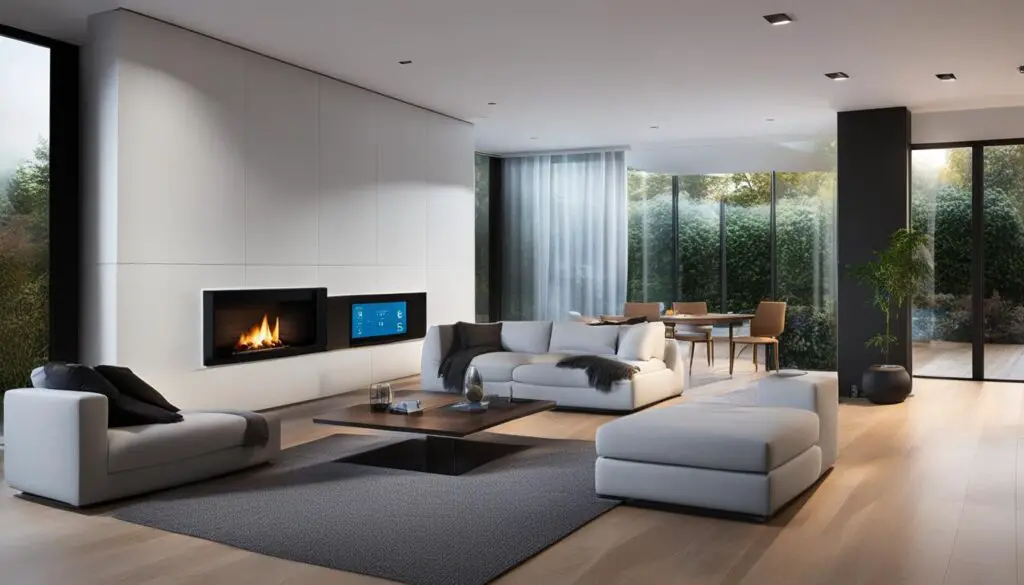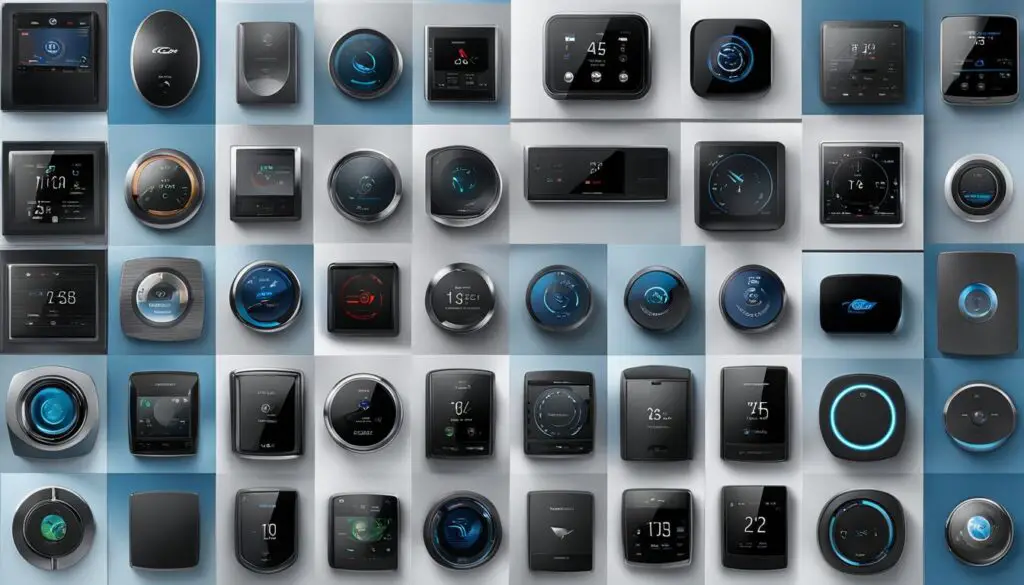In today’s fast-paced world, where convenience and energy efficiency are top priorities, smart home technology is gaining popularity among homeowners. One area where smart technology has made significant advancements is in climate control systems. From entry-level smart home climate control systems to advanced models, these innovative solutions offer a range of benefits for beginners and experienced users alike.
Entry-level smart home climate control systems are designed to provide homeowners with the ability to easily control the temperature and climate in their homes. Whether it’s maintaining the perfect temperature for optimal comfort or saving energy and reducing utility bills, these systems are a game-changer for homeowners.
If you’re new to the world of smart home technology, entry-level smart climate control systems are the perfect starting point. They offer simplicity, affordability, and seamless integration into your existing home setup. With just a few taps on your smartphone, you can experience personalized comfort and energy savings like never before.
Table of Contents
Key Takeaways:
- Entry-level smart home climate control systems provide an easy and affordable way to enhance comfort and save energy.
- These systems offer features like remote access, programmable schedules, and integration with other smart devices.
- Beginners can quickly understand and operate entry-level systems, making them an ideal choice for first-time smart home users.
- By investing in an entry-level smart climate control system, homeowners can enjoy personalized comfort and energy savings.
- Research and compare different brands and models to find the system that best fits your needs and budget.
Understanding Entry-Level Smart Climate Control Systems
Entry-level smart climate control systems offer homeowners easy-to-use, energy-efficient solutions for controlling the temperature and climate in their homes. These systems are designed to provide convenience, comfort, and cost savings by incorporating smart features and connectivity options.
These smart climate control systems come equipped with a range of features that enhance the overall user experience:
- Programmable Thermostats: By programming temperature settings based on specific times of the day, homeowners can optimize energy usage and avoid unnecessary heating or cooling.
- Remote Access: With smartphone apps, users can monitor and adjust the temperature in their homes from anywhere, providing ultimate control and flexibility.
- Integration with other Smart Home Devices: These systems can seamlessly connect and integrate with other smart home devices, allowing for automated climate control based on factors such as occupancy or weather conditions.
By taking advantage of these features, homeowners can experience several benefits:
- Greater Comfort: Smart climate control systems enable homeowners to maintain their desired temperature levels throughout the day, creating a comfortable living environment.
- Energy Savings: By optimizing temperature settings and avoiding unnecessary heating or cooling, homeowners can significantly reduce their energy consumption and save on utility bills.
- Convenience: The ability to control and monitor temperature settings remotely through smartphone apps adds a whole new level of convenience for homeowners, enabling them to make adjustments on the go.
“Smart climate control systems offer homeowners an effortless way to achieve comfort, energy savings, and convenience.”
To illustrate the benefits and features of entry-level smart climate control systems, let’s take a closer look at the following example:
| Feature | Benefits |
|---|---|
| Programmable Thermostats | Ability to schedule temperature settings for different times of the day, optimizing energy usage and ensuring comfort. |
| Remote Access | Convenience of controlling temperature settings from anywhere using a smartphone, allowing homeowners to easily adapt to their preferences and changing schedules. |
| Integration with other Smart Home Devices | Integration with devices like smart lighting or security systems enables automation and a cohesive smart home experience, enhancing overall comfort and convenience. |
Key Benefits of Entry-Level Smart Climate Control Systems
Entry-level smart climate control systems offer a range of benefits that enhance comfort, provide energy savings, and offer convenience to homeowners. These systems revolutionize the way we control the temperature in our homes, making it easier and more efficient than ever before.
Enhanced Comfort
With entry-level smart climate control systems, homeowners can enjoy personalized comfort throughout their homes. Using their smartphones, they can easily set and adjust the temperature from anywhere, ensuring their space is always at the desired level of warmth or coolness. Whether you’re upstairs, downstairs, or even away from home, you have full control over your home’s climate, allowing you to create the perfect environment for relaxation, work, or any other activities.
Energy Savings
One of the standout benefits of entry-level smart climate control systems is energy savings. By utilizing features such as programmable schedules and occupancy-based adjustments, these systems optimize energy consumption to minimize waste. For example, the system can automatically adjust the temperature when you’re not at home, reducing energy usage and ultimately lowering utility bills. By intelligently managing your heating and cooling, you not only reduce your carbon footprint but also save money in the process.
Convenience
The convenience offered by entry-level smart climate control systems is unparalleled. The ability to control your home’s temperature remotely using your smartphone provides an unprecedented level of convenience. Imagine being able to adjust the temperature before you arrive home, ensuring a comfortable environment as soon as you step through the door. Additionally, these systems can integrate with other smart devices in your home, enabling seamless automation and creating a truly connected and convenient living experience.
Entry-level smart climate control systems enhance comfort, provide energy savings, and offer unmatched convenience. With the ability to personalize your home’s temperature, optimize energy usage, and effortlessly control your system via smartphone, these systems are transforming the way we experience comfort and efficiency in our homes.
How Entry-Level Smart Climate Control Systems Work
Entry-level smart climate control systems operate through a combination of temperature sensors, a central control unit, and connectivity options. These systems are designed to provide homeowners with a seamless and intuitive way to control the temperature and climate in their homes.
The temperature sensors are strategically placed in different areas of the home to monitor the temperature. These sensors collect data and send it to the central control unit. The control unit acts as the brain of the system, analyzing the data and making necessary adjustments to the HVAC system to maintain the desired temperature.
The connectivity options, such as Wi-Fi or Bluetooth, play a crucial role in the operation of entry-level smart climate control systems. They allow homeowners to conveniently control the system using their smartphones or other smart devices. With the touch of a button, you can adjust the temperature, set schedules, and even monitor energy usage from anywhere in the world.
“Entry-level smart climate control systems offer homeowners a level of convenience and control that was once unimaginable. With temperature sensors, a central control unit, and connectivity options, these systems create a harmonious balance between comfort and energy efficiency.”
Whether you’re at home, work, or on vacation, you can easily ensure your home is always at the perfect temperature. This level of control not only enhances your comfort but also provides significant energy savings by optimizing the HVAC system’s operation.
Temperature Sensors: The Key to Precise Climate Control
The use of temperature sensors is the cornerstone of a smart climate control system’s operation. These sensors are responsible for monitoring the temperature in various parts of your home, allowing the system to make accurate and informed adjustments.
Temperature sensors work by detecting changes in the surrounding temperature. Once a change is detected, the sensors send updated data to the central control unit, enabling it to make real-time decisions on how to maintain the desired temperature.
Having temperature sensors in multiple areas of your home ensures that the system can account for temperature variations and adjust the HVAC system accordingly. For example, if the sun is shining directly into a particular room, causing it to heat up, the sensor in that room will alert the control unit, prompting it to adjust the cooling accordingly.
By leveraging temperature sensors, entry-level smart climate control systems can achieve precise and tailored climate control, ensuring your home is always at a comfortable temperature.

Enhancing Your Smart Climate Control System with Sensors and Automation
To further improve the efficiency and convenience of entry-level smart climate control systems, homeowners can consider integrating additional sensors and automation features. These enhancements not only optimize energy usage but also provide a more personalized and responsive climate control experience.
1. Occupancy Sensors:
Integrating occupancy sensors into your smart climate control system allows for automatic adjustments based on room usage. These sensors detect whether a room is occupied and can lower the temperature in unoccupied areas, ensuring energy is not wasted on heating or cooling empty spaces. For example, if a living room is empty during the day, the system can automatically adjust to a more energy-efficient setting until someone returns.
2. Smart Ventilation Systems:
Incorporating smart ventilation into your climate control setup can significantly enhance indoor air quality while maintaining comfort. Smart vents can open and close based on temperature readings and occupancy, ensuring that heated or cooled air is directed where it’s needed most. This targeted airflow not only increases comfort but also helps to save energy.
3. Weather-Based Automation:
Advanced weather sensors can provide real-time data about external temperature and humidity levels. By integrating these sensors with your smart climate control system, the system can automatically adjust the indoor climate in response to changing outdoor conditions. For instance, if a sudden heatwave is forecasted, the system can preemptively lower the indoor temperature to keep your home comfortable.
4. Energy Monitoring Tools:
Adding energy monitoring tools allows homeowners to gain insights into their energy consumption patterns. By analyzing usage data, homeowners can identify trends and make informed decisions about their heating and cooling practices. These insights can be crucial for optimizing energy savings and minimizing utility bills.
5. Voice-Controlled Integration:
For those who enjoy the latest tech, consider integrating your smart climate control system with voice assistants like Amazon Alexa or Google Assistant. This allows for hands-free control of your home’s climate, enabling you to make adjustments simply by speaking. This feature is particularly convenient for those with mobility challenges or busy lifestyles.
Popular Brands and Models of Entry-Level Smart Climate Control Systems
When it comes to entry-level smart climate control systems, there are several popular brands and models that homeowners can choose from. These brands offer user-friendly interfaces, advanced features, and compatibility with other smart home devices. Let’s take a closer look at some of the top choices:
- Nest Learning Thermostat
- Ecobee SmartThermostat
- Honeywell Lyric T5

These brands have established themselves as leaders in the smart home industry, providing homeowners with reliable and innovative solutions for climate control. Each brand offers unique features and benefits that cater to different needs and preferences.
The Nest Learning Thermostat, for example, is known for its intuitive learning capabilities that adapt to the homeowners’ preferences and schedule. It also offers energy-saving features and integration with other smart home devices.
The Ecobee SmartThermostat offers similar features, including remote access and compatibility with popular voice assistants like Amazon Alexa and Google Assistant. It also supports room sensors, allowing for more precise temperature control and energy efficiency.
Honeywell Lyric T5 is another popular choice, known for its affordability and ease of use. It offers basic smart thermostat features like smartphone control and automated scheduling.
Before making a decision, it’s important to research and compare different models to find the one that best fits your needs and budget. Consider factors such as compatibility, features, and customer reviews to make an informed choice.
Comparison Table: Popular Entry-Level Smart Climate Control Systems
| Brand | Model | Key Features | Compatibility |
|---|---|---|---|
| Nest | Learning Thermostat | – Intuitive learning capabilities – Energy-saving features – Integration with other smart home devices | – Works with most HVAC systems – Compatible with iOS and Android devices |
| Ecobee | SmartThermostat | – Remote access via smartphone – Room sensors for precise temperature control – Integration with voice assistants | – Works with most HVAC systems – Compatible with iOS and Android devices |
| Honeywell | Lyric T5 | – Smartphone control – Automated scheduling – Energy-saving features | – Works with most HVAC systems – Compatible with iOS and Android devices |
As you can see from the comparison table, each brand and model offers its own set of features and compatibility options. This table can help you narrow down your choices and make an informed decision based on your specific requirements.
Considerations for Choosing an Entry-Level Smart Climate Control System
When it comes to selecting an entry-level smart climate control system, there are several factors that you should take into consideration. Let’s explore these important factors that can help you make an informed decision:
- Compatibility: Before purchasing a smart climate control system, ensure that it is compatible with your existing HVAC system. Compatibility is crucial for seamless integration and optimal performance. Additionally, check if the system is compatible with other smart devices in your home, such as smart speakers or home automation hubs.
- Features and Capabilities: Consider the range of features and capabilities offered by the smart climate control system. Look for features like temperature scheduling, which allows you to program different temperature settings based on your daily routine. Remote access via smartphone apps is another useful feature that enables you to monitor and control the temperature of your home from anywhere. Energy-saving options like smart sensors and adaptive algorithms can also contribute to reducing energy consumption and lowering your utility bills.
- Budget: Your budget is an essential factor to consider when choosing a smart climate control system. Determine your price range and compare different models within that range. Keep in mind that while higher-priced systems may offer more advanced features, there are often entry-level options that provide excellent value for money.
“When choosing a smart climate control system, remember to prioritize compatibility, consider the features and capabilities, and stay within your budget.”
By taking these factors into account, you can make a well-informed decision that aligns with your needs and preferences. It’s important to find a smart climate control system that not only fits your budget but also enhances your comfort and energy efficiency.
| Factors to Consider | Features | Budget Range |
|---|---|---|
| Compatibility | Integration with existing HVAC system and other smart devices | Varies based on brand and model |
| Features and Capabilities | Temperature scheduling, remote access, energy-saving options | Entry-level systems available within a wide range of budgets |
| Budget | Cost-effective options available with competitive features | Depends on individual preferences and requirements |
Conclusion
Entry-level smart climate control systems are the perfect solution for homeowners who want to enhance their comfort and save energy. These systems offer an easy and affordable way to control the temperature in your home, providing a convenient and efficient experience.
With features like remote access, programmable schedules, and integration with other smart devices, entry-level smart climate control systems offer a seamless solution for managing the climate in your home. You can easily adjust the temperature from anywhere using your smartphone, ensuring personalized comfort and energy savings.
Whether you’re a beginner or an experienced smart home enthusiast, investing in an entry-level smart climate control system is a smart choice. These systems provide not only comfort and convenience but also energy savings, allowing you to reduce your carbon footprint and lower your energy bills.
FAQ
What are entry-level smart home climate control systems?
Entry-level smart home climate control systems are designed to provide homeowners with easy-to-use, energy-efficient solutions for controlling the temperature and climate in their homes.
What are the key features and benefits of entry-level smart climate control systems?
Entry-level smart climate control systems typically include features like programmable thermostats, remote access via smartphone apps, and the ability to integrate with other smart home devices. The key benefits include enhanced comfort, energy savings, and convenience.
How do entry-level smart climate control systems work?
Entry-level smart climate control systems consist of temperature sensors, a central control unit, and connectivity options. The temperature sensors monitor the temperature in different areas of the home and send the data to the central control unit, which analyzes the data and adjusts the HVAC system accordingly to maintain the desired temperature.
What are some popular brands and models of entry-level smart climate control systems?
Some popular brands and models include Nest Learning Thermostat, Ecobee SmartThermostat, and Honeywell Lyric T5. These brands offer user-friendly interfaces, advanced features, and compatibility with other smart home devices.
What factors should I consider when choosing an entry-level smart climate control system?
When choosing a system, consider compatibility with your existing HVAC system and other smart devices, features and capabilities such as temperature scheduling and remote access, and your budget.


